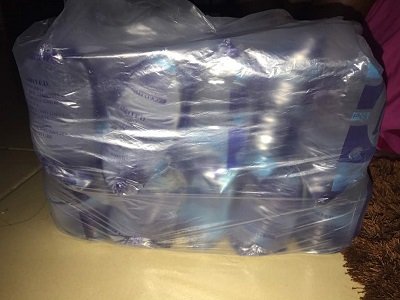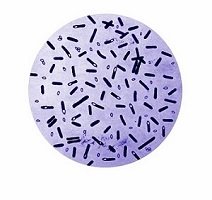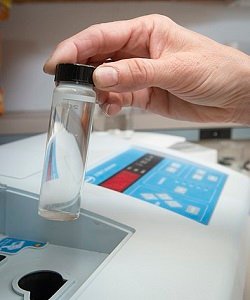Why You Should be Careful about Consuming Sachet Water
Water is very important and essential for the survival of both humans and micro-organisms. It is a transparent, odourless and tasteless liquid that is important for the circulation and movement of essential nutrients, it’s also an important molecule that helps to flush out pathogens and waste and also aids digestion. As higher animals we need water for both domestic functions and also in maintaining the human cell; for the unicellular organisms, water is necessary for their activity as either beneficial or detrimental organisms.
Until now it was a regular habit for me to buy any available Packaged sachet water(Popularly called Pure water in Nigeria where I reside) whenever I am thirsty, of course, I was always satisfied and saw nothing wrong doing this, even as a Microbiologist. For those who are not Nigerians, packaged 500ml sachet water commonly called "Pure water" is sold for 10 or 20 Naira depending on your location and it is usually purchased by people of the lower class or when water packaged in pet container is not readily available, however for some it is a cheaper alternative to water packaged in pet container otherwise known as bottled water that sells from 50 to 80 Naira per bottle.
Please be careful oh as this cheaper pure water can expose you to typhoid, diarrhoea, cholera, hepatitis, and carcinogenic agents especially when the polythene bag used to package the water is being stored in an unclean condition, exposed to sunlight, or is of very low quality.
Both the illiterate and some educated people call it "Pure water" forgetting that even Water in its natural state is not totally pure, even rainwater which is presumed by the layman as water coming directly from the sky is contaminated by the combustion of fossil fuel and the sulphur compound responsible for acid precipitation as it falls to the earth.
This packaged water is generally accepted although research in some part of the country has shown that most packaged sachet water is neither portable nor safe for consumption. In fact, some researchers believed that these sachet water vendors do not treat nor screen their sachet water for pathogens before selling it out for consumption. National Agency for Food and Drug Administration and Control (NAFDAC) is, however, the agency mandated to regulate the production of pure water. The agency is also supposed to make sure that the bacteriological standards used for screening are met with according to the recommended WHO standard for the screening of water.
With the recent incidence of cholera in Adamawa state and the increase in the number of people suffering from Typhoid, gastroenteritis, diarrhoea, typhoid (all these diseases might be as a result of drinking water of poor quality) it is necessary for people like me who consume “Pure water” to bear in mind that this water may contain chemicals not safe for consumption or pathogenic organisms.
Some of the sachet water producers often claim that the water has been ozonised, as this is clearly written on the sachets. Hmmm, Ozone water treatment that I know of is expected to be more effective than chlorine in destroying bacterial and viral pathogens within a short period of time (about 10 to 30 minutes), however, the process ozonisation of water requires a more complex technology than UV disinfection and chlorination.
The disturbing question to be answered by the packaged water vendors or producers is if they are sure that they treat and screen their sachet water for pathogens before selling it out for consumption? If yes why do we still isolate some pathogens from their products? I won’t be tempted to answer this question but it is important to note that viruses, protozoan cyst and spores may not be destroyed or inactivate if the dosage of ozone added is not adequate for the volume of water to be treated. Using this method for treatment is also expensive and requires an intensive power supply. Is the 10 Naira paid for purchasing this “Pure water” enough to provide 500ml of potable water? I hope someone will read and provides answers to these questions.
Pathogens that can be transmitted from drinking Sachet Water
- Bacteria
When organisms such as Escherichia coli, Streptococcus faecalis or Clostridium perfringens that are not found freely in nature expect when in faeces are isolated from water sample then the water is said to be contaminated. This group of organisms are called coliforms or indicator organisms. Other kinds of bacteria that are not coliforms include Staphylococcus aureus, Vibrio cholerae, Campylobacter sp, Shigella sp, and Salmonella sp.
- Parasites
Waterborne parasites include Naegleria fowleri, Entamoeba hystolitica, Acanthamoeba sp Giardia lamblia and Cryptosporidium parvum. Some protozoans such as Cryptosporidium parvum and Giardia lamblia are considered the most important pathogens when testing the quality of water because they are usually resistant to disinfectants used for water treatment and are able to survive harsh environmental condition (form thick-walled oocysts and cysts) and therefore live for a very long time in the environment.
- Viruses
Rotavirus, Enterovirus, Norovirus and hepatitis A are viral pathogens associated with water. Factories involved with the production of sachet water should try to reduce the amount of virus by about 99%, this can be achieved by coagulation and filtration although inactivation by chemical oxidant and photooxidation might also be of help.
I only became more conscious only recently after some of my students isolated *Escherichia coli from packaged sachet water which is presumed to be pure by the public. The presence of E.coli in water is an indication of faecal contamination but isn’t this funny? What could have been the source of the contamination, I only reasoned and concluded that it could have been from the hands of workers in the factory as I want to believe that packaged water will not be sold without checking to ascertain that bacteriological standards as recommended WHO standard for the screening of water are achieved before selling out to the public for consumption.
Escherichia coli isolated belongs to a group called the Coliforms. The following characteristics are exhibited by organisms in this group:
- They are gram-negative and non-spore forming
- Rod-shaped bacteria
- Facultative anaerobic organisms and
- They ferment lactose with gas formation within 48hours at 35OC.
Detecting Coliforms in water
The test process that was originally used in detecting coliforms gives an estimate of the most probable number (MPN) of coliforms in the water. Completing this process requires at least 4days of incubations and transfers of the sample, This procedure can be discouraging, however simpler and more specific tests have been developed and these include:
- Membrane filtration technique which is the preferred method of evaluating the microbiological characteristics of water. This technique can easily be reproduced and larger volumes of the water sample can be processed to increase the assay sensitivity.it is also cheaper to conduct when compared to the process of estimating the most probable number (MPN) of coliforms in the water
- Molecular techniques are now also used routinely to detect coliforms in water and other environments. With the Use of 16S rRNA gene-targeted primers for coliforms, it is possible to detect one colony-forming unit (CFU) of E.coli per 100 ml of water.
Manufacturers of sachet water have the opportunity of making use of the easier and accurate method and therefore have no excuse for not properly screening water meant for consumption.
Conclusion
It is a statement of fact that some sachet water sold for public consumptionare contaminated with pathogens especially bacteria as research work by Adewoye, Mgbakor and other Nigerian environmental microbiologists are enough to prove this fact. The goal of the sachet water producers should be providing good and potable water and not just all about profit making, it is an unfortunate situation that there are only a few alternatives to sachet water which are not affordable by the “common man”.
The need for regulatory bodies to intensify efforts in ensuring that the output from water packaging factories meet with the required standard cannot be overemphasised.
Adequate training of staffs in these factories is also important as most do not understand why appropriate treatment processes are required for the production of quality and potable packaged drinking water
Thank you for reading, expecting your comments and questions.
References
If you write STEM (Science, Technology, Engineering, and Mathematics) related posts, consider joining #steemSTEM on discord [here](https://discord.gg/vwzWz3Z). You can also check this blog post by [@steemstem here](https://steemit.com/steemstem/@steemstem/being-a-member-of-the-steemstem-community) and this [guidelines](https://steemit.com/steemstem/@steemstem/helpful-guidelines-for-crafting-steemstem-content) here for help on how to be a member of @steemstem. Please take a step further to also check this blog post from @steemstem on [proper use of images devoid of copyright issues here](https://steemit.com/steemstem/@steemstem/guidelines-on-copyright-standards-in-steemstem)





I thought we've already built a tolerance to bad water and food :)
By "we" I mean those that grew up drinking all types of "unsafe" water such as rainwater collected from the roof, drinking from the nearest free flowing stream, wells, etc.
@greenrun, thank you for always sparing time to read my post. tolerance to bad water, if that is the case then the recent Cholera outbreak in Adamawa state won not have occurred, the increase in the incidence of typhoid and gastroenteritis in our hospitals especially for those of us in "rugged areas" would have been a thing of the past. The reasonable answer to this development of tolerance is because our immune system is functioning at its optimal state, any suppression in the immune response will result in infection if contaminated water is consumed.
The effect of drinking bad water also depends on the microbial of the water and the pathogenic ability of the organisms involved, therefore @greenrun, we are been saved by the immune system's ability to wade into a successful fight with pathogens.
Thank goodness for a strong immune system, though I was lucky not to have a cholera epidemic when I drink all sorts of water. Today, I'm fortunate to get clean water devoid of all those harmful germs.
Hey @ugonma, how about plastic table water, does these apply to it?!
@gidioline, thank you for commenting, in my next post (in a few hours from now) I will be talking about table water and water packed in dispensers, for now, I will not let the cat out of the bag. Thank you
These facts are scary. It's only just amazing that we know these things, but we still continue drinking "pure water" because there's no much reliable and handy alternative around us.
Thank you for reading @dsndymee. Like I also said, there Is no alternative, the government has failed to provide potable water for her citizens, all we can do is to regulate the production of sachet water. Don't forget that some of the them are good for consumption but there are only a few.
Thank you
Hello ugonma!
Congratulations! This post has been randomly Resteemed! For a chance to get more of your content resteemed join the Steem Engine Team
Hi @ugonma!
Your post was upvoted by utopian.io in cooperation with steemstem - supporting knowledge, innovation and technological advancement on the Steem Blockchain.
Contribute to Open Source with utopian.io
Learn how to contribute on our website and join the new open source economy.
Want to chat? Join the Utopian Community on Discord https://discord.gg/h52nFrV
Good work. A very enlightening post.
Thanks for reading @conas
I think the first question we should ask ourselves is how sincere are the regulatory bodies are to their work? Many "Pure water" manufacturers knows how they boycott or carry out window dressing when NAFDAC or SON about to check non their activities.
I will refer to this as the big question of the day?. To some extent ,I think I would say yes because the purification process is same for a large amount of water volume to be treated. So just a fraction not the large volume is dispensed into the sachet. The process for 200000 litre purification will be same for 5000 ,just volume difference. Besides, the main source is Natural,just the purification process, packaging and marketing that we are paying for. I rest my submission. 😁
My brother thank you oh, some don't even employ the services of a chemist or microbiologist and they still get certified.
If the 10 naira can pay for 500ml of sachet water then what excuses have they not to treat and screen before selling out to the public for consumption.
God will help us.
Thank you for reading and trying to solve the puzzles.
As for me I will blame the bodies in charge of this association.... after collecting bribe they act like they knew nothing
Thanks for your contribution @godvesselt.
Chaii, you just created fear in me. Which water will i use to wash this food down now.
@rharphelle please don't scared oh, I was only trying to create awareness and reduce the possibility of acquiring infection through public education.
Thank you for reading.
This is serious, I consume these sachets water everyday to save money. Well as a student plastic water is too expensive for me, only God will save me from these risks.
Thank you for reading @elizabeth. may God save us.
Amen ooooo